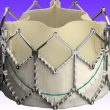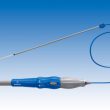Courtesy of Dr. Carlos Fava. TAVR has matured over time and has advanced onto low risk patients, but one of its greatest challenges continues to be bicuspid valve patients. These represent between 1% and 2% of the population and over 20% of young adults requiring surgical valve replacement (SAVR). The study looked at 27,086 patients<a href="https://solaci.org/en/2020/08/28/good-evolution-of-bicuspid-valves-with-evolute-or-evolute-pro/" title="Read more" >...</a>
Surgical Valve Replacement Might Soon Be History
Patients with dysfunctional biological prosthetic valves have better outcomes with TAVR vs. surgical reintervention, beyond surgical risk. This study outcomes might even call into question the age cutoff to consider a mechanical vs. a biological prosthesis at first surgery. This analysis recently published in JACC looked at the outcomes of both possible strategies to treat<a href="https://solaci.org/en/2020/08/26/surgical-valve-replacement-might-soon-be-history/" title="Read more" >...</a>
Valve in Valve Presents Better Evolution than re-SARV
Courtesy of Dr. Carlos Fava. Surgical aortic valve replacement with bioprosthesis has proved its benefits, but it fails after 10 to 15 years. Transcatheter aortic valve replacement has been shown valid, especially in high risk patients, but we still have little information and no “head to head” studies to know what is best in this<a href="https://solaci.org/en/2020/08/04/valve-in-valve-presents-better-evolution-than-re-sarv/" title="Read more" >...</a>
After 8-year Followup, Good News for the Self Expandable Valve
As the transcatheter aortic valve replacement (TAVR) gains ground in lower risk populations and with better survival rate, concern over its durability has grown. This study brings us data and good news on the first-generation self-expandable valve after quite a long follow up. It included 990 inoperable or high-risk patients treated with CoreValve in 8<a href="https://solaci.org/en/2020/07/22/after-8-year-followup-good-news-for-the-self-expandable-valve/" title="Read more" >...</a>
EuroPCR 2020 | Aortic Valve in Valve in the Long Term
The outcomes of this work are important to plan valve replacement with the largest possible prosthesis allowed by patient anatomy in the index procedure. As a worldwide trend, increasingly more patients are receiving bioprostheses, which have improved a lot but still tend to become deteriorated and require a valve-in-valve procedure if the patient is no<a href="https://solaci.org/en/2020/07/13/europcr-2020-aortic-valve-in-valve-in-the-long-term/" title="Read more" >...</a>
Self-Expanding Valve vs. Balloon-Expandable Valve, Randomized, Head to Head
The “arms race”among transcatheter valves has been vertiginous. By the time we received the mid- or long-term outcomes of studies focused on a given valve, we were already using its next generation in clinical practice. As a result, there is little information addressing which valve is the best. Nowadays, this “arms race” has reached a<a href="https://solaci.org/en/2020/06/24/self-expanding-valve-vs-balloon-expandable-valve-randomized-head-to-head/" title="Read more" >...</a>
TAVR: Balloon-Expandable or Self-Expanding Valves, Which Is the Answer?
Courtesy of Dr. Carlos Fava. Transcatheter aortic valve replacement (TAVR) has shown benefit and is currently moving towards low-risk patients, as well as bicuspid aortic valves and (to a lower extent) aortic regurgitation. However, we must ponder on which valve should be used on each patient: balloon-expandable (BE) or self-expanding (SE) valve? They represent different technologies<a href="https://solaci.org/en/2020/06/03/tavr-balloon-expandable-or-self-expanding-valves-which-is-the-answer/" title="Read more" >...</a>
Malignancies and Aortic Stenosis: Is TAVR Warranted?
This meta-analysis tells us that patients with active malignancies and severe aortic stenosis have a good evolution after transcatheter aortic valve replacement (TAVR), except for a higher rate of pacemaker implantation in the general population. These patients must not be limited to respite care only, at least as far as aortic stenosis is concerned. Short-term<a href="https://solaci.org/en/2020/05/26/malignancies-and-aortic-stenosis-is-tavr-warranted/" title="Read more" >...</a>
Aligning Prosthetic Valves to Native Commissures: The Secret to Coronary Artery Obstruction?
Preventing coronary artery obstruction during transcatheter aortic valve replacement (TAVR) continues to be a challenge. There are techniques to prevent (or at least reduce) this from happening, which could be catastrophic. However, they all somehow fall into palliative care, that is, they will merely provide relief, rather than a cure. Commissure overlapping and the resulting<a href="https://solaci.org/en/2020/05/26/aligning-prosthetic-valves-to-native-commissures-the-secret-to-coronary-artery-obstruction/" title="Read more" >...</a>
TAVR Reaches Low-Risk Patients with Bicuspid Valves
Transcatheter aortic valve replacement (TAVR) seems to be safe in low-risk patients with bicuspid aortic valve stenosis. Their hospital length of stay was very short, with zero mortality, and zero disabling stroke. Subclinical leaflet thrombosis and device durability are still unknown. The United States Food and Drug Administration (FDA) approved TAVR for low-risk patients. However,<a href="https://solaci.org/en/2020/04/27/tavr-reaches-low-risk-patients-with-bicuspid-valves/" title="Read more" >...</a>








